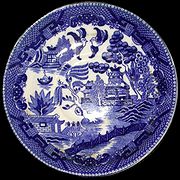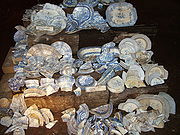
Willow pattern
Encyclopedia


Thomas Minton
Thomas Minton was an English potter. He founded Thomas Minton & Sons in Stoke-on-Trent, Staffordshire, which grew into a major ceramic manufacturing company with an international reputation....
around 1790 and has been in use for over 200 years. Other references give alternative origins, such as Thomas Turner of Caughley porcelain, with a design date of 1780. Willow refers to the pattern, a specific treatment, either applied transfer, or stamp, known as transferware
Transferware
Transferware is a style of ceramics including pottery, dinnerware, and other delicate items. It uses transfer printing, a decorative technique which was developed in England in the mid-18th century, particularly around the Staffordshire region....
. Background colour is always white, while foreground colour depends on the maker; blue the most common, followed by pink, green, and brown. Assortment, shape and dates of production vary.
Legend behind the pattern
In order to promote sales of Milton's Willow pattern, various stories were invented based on the elements of the design. The most famous story usually runs as described below. The story is English in origin, and has no links to China.The Romantic Fable: Once there was a wealthy Mandarin
Mandarin (bureaucrat)
A mandarin was a bureaucrat in imperial China, and also in the monarchist days of Vietnam where the system of Imperial examinations and scholar-bureaucrats was adopted under Chinese influence.-History and use of the term:...
, who had a beautiful daughter (Koong-se). She had fallen in love with her father's humble accounting assistant (Chang), angering her father (it was inappropriate for them to marry due to their difference in social class). He dismissed the young man and built a high fence around his house to keep the lovers apart. The Mandarin was planning for his daughter to marry a powerful Duke. The Duke arrived by boat to claim his bride, bearing a box of jewels as a gift. The wedding was to take place on the day the blossom fell from the willow tree.
On the eve of the daughter's wedding to the Duke, the young accountant, disguised as a servant, slipped into the palace unnoticed. As the lovers escaped with the jewels, the alarm was raised. They ran over a bridge, chased by the Mandarin, whip in hand. They eventually escaped on the Duke's ship to the safety of a secluded island, where they lived happily for years. But one day, the Duke learned of their refuge. Hungry for revenge, he sent soldiers, who captured the lovers and put them to death. The Gods, moved by their plight, transformed the lovers into a pair of doves (possibly a later addition to the tale, since the birds do not appear on the earliest willow pattern plates).
The Secret Shaolin Message: The Shaolin Monastery is burned by the Imperial troops of the Manchu rulers, called invaders by Chinese nationalist and later communist factions. Souls of the dead monks take a boat to the isle of the Blest. On the bridge are three Buddha
Buddhahood
In Buddhism, buddhahood is the state of perfect enlightenment attained by a buddha .In Buddhism, the term buddha usually refers to one who has become enlightened...
awaiting the dead souls: Sakyamuni, the Buddha of the Past; Maitreya, the Buddha of the Future; and, Amitabha, the Ruler of the Western Paradise. Beyond them is the City of Willows – Buddhist Heaven. The doves are the monks' souls on the journey from human to immortal life.
The teller narrates the tale while pointing to various designs on the plate.
Cultural impact of the story: The story of the willow pattern was turned into a comic opera
Comic opera
Comic opera denotes a sung dramatic work of a light or comic nature, usually with a happy ending.Forms of comic opera first developed in late 17th-century Italy. By the 1730s, a new operatic genre, opera buffa, emerged as an alternative to opera seria...
in 1901 called The Willow Pattern
The Willow Pattern
The Willow Pattern is a one-act comic opera with a libretto by Basil Hood and music by Cecil Cook. It was first performed at the Savoy Theatre on 14 November 1901, running for a total of 110 performances. It toured thereafter....
. It was also told in a 1914 silent film called Story of the Willow Pattern. Robert van Gulik
Robert van Gulik
Robert Hans van Gulik was a highly educated orientalist, diplomat, musician , and writer, best known for the Judge Dee mysteries, the protagonist of which he borrowed from the 18th-century Chinese detective novel Dee Goong An.-Life:Robert van Gulik was the son of a medical officer in the Dutch...
also used some of the idea in his Chinese detective novel The Willow Pattern. In 1992, Barry Purves
Barry Purves
Barry J.C. Purves is an English animator, director and writer of puppet animation and also a designer and director of stage plays, primarily for the Altrincham Garrick Playhouse in Manchester...
made a short animated film relating the story, transplanted to Japan and entitled Screen Play.
The old poem:
Two birds flying high,
A Chinese vessel, sailing by.
A bridge with three men, sometimes four,
A willow tree, hanging o'er.
A Chinese temple, there it stands,
Built upon the river sands.
An apple tree, with apples on,
A crooked fence to end my song.
External links
- Site shows a beautiful photograph of the pattern
- Site links to a transcript of the Legend of the willow pattern
- Another site with information about the legend of the willow pattern
- The Spode Museum Trust's Willow Pattern webpage
- Legend of the Willow Pattern Plate by Mary L. Stollard
- Short animated film telling Blue Willow legend
- Animated version of the story by children at Dorchester ARTS*

